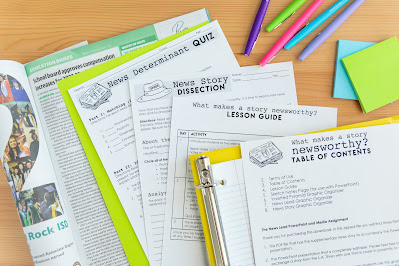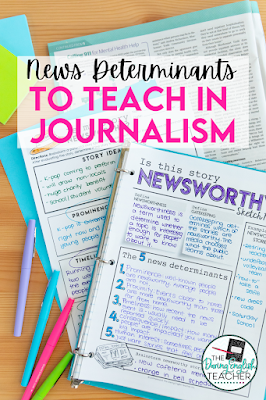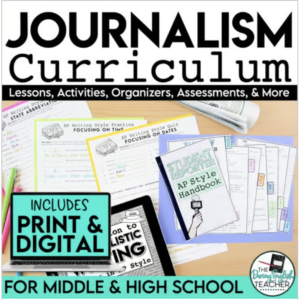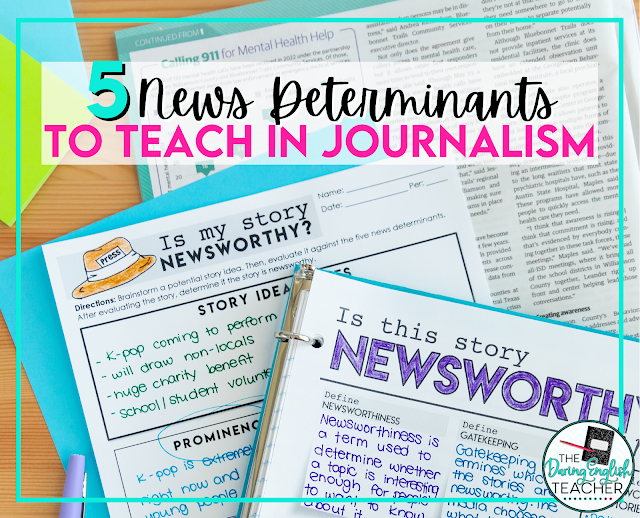One of the most critical middle school and high school journalism lessons you can teach your students journalists is about the main news determinants. Before student journalists know how to write, they should know what to write about.
Picture this: as a journalism adviser in charge of your school’s newspaper, you engage your students in a brainstorming session about potential stories for the upcoming issue. While your students have great ideas and pitch exciting ideas for stories, their ideas lean more toward detailed feature pieces or even argument essay topics. At the end of the brainstorming session, while you may have a long list of topics for your students to write about, your students missed the mark on identifying truly newsworthy stories for your school. 
Teaching students about the news determinants and what makes a story or topic newsworthy for publication in the school newspaper is one of the first lessons I teach my journalism students at the start of every school year.
What makes a story newsworthy is such an important topic for high school journalism that it is often a topic that I refer to several times throughout the year. Here is a look at the five news determinants that I teach to my student journalists.
When teaching this concept to my students, I use this news determinant lesson, which is also included in my ultimate journalism teaching unit.
Teaching the Five News Determinants for Student Journalists
Prominence
Prominence refers to people, places, and events that the story is about. To best serve a school publication’s population, student journalists need to keep prominence in mind. Writing stories about well-known people, places, and events that will be interesting to a large section of the audience will have a big appeal.
Proximity
Another essential news determinant is proximity. This refers to how close the story’s subject (person, event, etc.) is physically located to the school. Most of your publication’s news stories will have a lot of proximity to your school. In other words, students should be writing news stories about the school, its events, sports, and people.
Timeliness
Timeliness is another news determinant that can affect a story’s newsworthiness. Timeliness is key in journalism, especially if your publication also has immediate access to publish stories online. You will want your students to write news stories about events that are about to happen, currently happening, or just happened. Once too much time elapses from the publication date and the events, the story loses its newsworthiness.
Consequence/Impact
Another news determinant to have your students consider is consequence and impact. This news determinant refers to how many people the story’s subject will affect. The bigger consequence and impact a potential story might have, the better.
Human Interest
Finally, the last news determinant to consider is human interest. It is only human nature to want to read stories about topics that make them feel good or are very intriguing. Usually, human interest pieces will either be emotional, have conflict, be unique, or have a mix of the three elements.
Teaching Journalism: Starting with the Story 
Now that you know the five news determinants your students should be thinking about when pitching story ideas let’s discuss how we can help students consider these determinants as they come up with potential story ideas.
As part of my students’ story package (what I call a completed document with the headline, byline, section, photos, photo credit, photo caption, etc.), I have them include which news determinants are present in this story. My student journalists keep those determinants in mind as they plan, research, interview, and write their stories, which helps them produce a better-quality story more suited for a student publication.
Another way to actively use these news determinants in the scholastic journalism setting is to have students pre-pitch their stories. For example, I use Canvas as my LMS in the classroom, and before we even have our pitching session, each student will submit three potential news stories to just me. In the online assignment, I ask students to include the story, a possible angle, and an explanation of at least two news determinants that the story has. In doing so, my student journalists are better prepared for pitching day.
Once student journalists understand what makes a story newsworthy, they are then ready to begin implementing AP style and journalistic writing to their story ideas. For more ideas for teaching journalism, check out this blog post about five activities to do in the journalism class.
Journalism Curriculum for School Publications

Make teaching journalism and advising the school newspaper a breeze with this journalism curriculum! This journalism curriculum has everything you need to get your journalism students started on the right foot and working on a successful newspaper -whether you publish in print or digitally!
From learning basic journalism terminology to news writing to the inverted pyramid to AP Style writing, this curriculum has everything you need to get your student journalists writing and publishing high-quality news stories. This journalism curriculum works for both middle school journalism and high school journalism.
JOURNALISM ADVISERS LIKE YOU SAID…
⭐️⭐️⭐️⭐️⭐️ Doreen T. says, “This helped me SO MUCH with the first journalism class I’ve ever taught. The powerpoints are amazing – very informative, thorough, and visually appealing. Not sure what I would have done without this resource! .”
⭐️⭐️⭐️⭐️⭐️ Midwestern Miss says, “Omgoodness! As a teacher who hasn’t taught journalism in 8 years, this saved me! I was able to print and go. The kids loved being able to create their own AP mini books and were laughing at each other’s crafting abilities. Bringing some artistic time into the room before we start the yearbook!”
⭐️⭐️⭐️⭐️⭐️ Geneva W. says, “Thank you for this amazing resource! I am teaching a journalism class for the second time this year. Last year I bought a few of your lessons, but this year I splurged on the whole package, and I am so thankful that I did! It really has been an essential part of building my journalism class. Pretty much everything is taken care of for me, and I feel confident in presenting the materials even though journalism is not my strength.”


